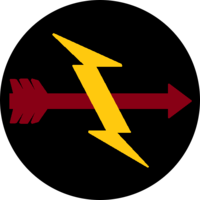24th Infantry Division (Bangladesh)
| 24th Infantry Division | |
|---|---|
 Insignia of 24th Infantry Division | |
| Active | 1976-present |
| Country | |
| Branch | |
| Type | Infantry |
| Size | Division (military) |
| Garrison/HQ | Chittagong Cantonment |
| Commanders | |
| Current commander | Major General Md Mainur Rahman |
| Notable commanders | Major General Atiqur Rahman Major General Abul Manzoor Major General Iqbal Karim Bhuiyan Major General Saiful Abedin |
24th Infantry Division is a formation of the Bangladesh Army, headquartered in Chittagong Cantonment, Chittagong District. It is the largest division of the Bangladesh Army.[1]
History
[edit]In 1972, five brigades of Bangladesh Army were formed. Among them, 65th Infantry Brigade was headquartered in Chittagong. Later in 1976, the brigade was upgraded as the 24th Infantry Division and Maj. Gen. Atiqur Rahman was its first commander.[citation needed]
On 3 April 2016, Major General Shafiqur Rahman was replaced as general officer commanding (GOC) by Major general Jahangir Kabir Talukder.[2]
The division covers the Chittagong Hill Tracts. 24th Infantry Division is the largest infantry division that comprises 33% of the personnel of the Bangladesh Army.[3]
Components
[edit]- 24th Artillery Brigade (Guimara Cantonment)
- 69th Infantry Brigade (Bandarban Cantonment)
- 203rd Infantry Brigade (Khagrachari Cantonment)
- 305th Infantry Brigade (Rangamati Cantonment)
Operation Dragon Drive
[edit]Post-independence, Purba Banglar Sarbahara Party emerged as one of the main opponents of the new Awami League-government. In April 1973, the Purba Banglar Jatiya Mukti Front, a coalition of 11 groups, was formed. After the formation of the front, the party initiated a campaign of armed struggle against the Bangladeshi state. The party was active in the Dhaka, Barisal, Faridpur, Mymensingh, Tangail, Chittagong, Sylhet and Comilla districts. It carried out assassinations of Awami League cadres and attacks on police stations throughout the country.[4][5]
At the request of Sheikh Mujibur Rahman, then 65th Infantry Brigade commander Brig. (later Maj. Gen.) Dastgir took over counter-insurgency operations in his command area and led Bangladesh's first successful combined army, navy, air force military operation called Operation Dragon Drive in the Chittagong Hill Tracts region against Shorbohara separatist insurgents in the Chittagong Hill Tracts.[citation needed]
Assassination of Ziaur Rahman
[edit]On 29 May 1981, Zia went on tour to Chittagong to help resolve an intra-party political dispute in the regional BNP. Zia and his entourage stayed overnight at the Chittagong Circuit House in Chittagong Cantonment. In the early hours of the morning of 30 May, he was assassinated by a group of army officers led by GOC of 24th Infantry Division Major General Abul Manzoor. Also killed were six of his bodyguards and two aides.[6]
Manzoor was killed shortly after while being captured.[7] 18 officers were brought before a military tribunal, 13 were sentenced to death whilst 5 were given varying prison sentences a hasty trial in a military court.[8]
Chittagong Hill Tracts conflict
[edit]The Chittagong Hill Tracts Conflict was the political conflict and armed struggle between the Government of Bangladesh by the Parbatya Chattagram Jana Sanghati Samiti (United People's Party of the Chittagong Hill Tracts) and its armed wing, the Shanti Bahini over the issue of autonomy and the rights of the tribes of the Chittagong Hill Tracts.
The Shanti Bahini launched an insurgency against government forces in 1977. 24th Infantry Division of Bangladesh Army took part in this counter-insurgency operation. The conflict continued for twenty years until the government and the PCJSS signed the Chittagong Hill Tracts Peace Accord in 1997.[9][10] In February 1998, Shantu Larma formally disbanded the Shanti Bahini. Almost 1,500 fighters surrendered their weapons.[11] According to official figure more than 8,500 rebels, soldiers and civilians have been killed during two decades of insurgency. The number of civilians killed is estimated at 2,500.[12]
References
[edit]- ^ "PM Hasina says only 4 army brigades will be retained in Chittagong Hill Tracts". bdnews24.com. 8 May 2016. Retrieved 2017-03-04.
- ^ "New DG at SSF". New Age. 2016-04-03. Archived from the original on 2017-01-16. Retrieved 2017-03-09.
- ^ "Igia" (PDF). Archived (PDF) from the original on 2017-03-29. Retrieved 2017-03-04.
- ^ "Sikder, Siraj". Banglapedia. Archived from the original on 2019-06-10. Retrieved 2017-03-09.
- ^ "Radical Politics". Banglapedia. Archived from the original on 2017-07-06. Retrieved 2017-03-09.
- ^ "Bangladesh: Death at Night". Time. 8 June 1981. p. 41. Archived from the original on 30 September 2007. Retrieved 10 September 2006.
President Ziaur Rahman, only 45, lay dead with two aides and six bodyguards in a government rest house in Chittagong. All were reportedly shot by an assassination squad, led by [Major General] Manjur, in the early morning hours Saturday
- ^ Codron, Jérémie (2007-10-18). "Putting Factions 'Back in' the Civil-Military Relations EquationGenesis, Maturation and Distortion of the Bangladeshi Army". South Asia Multidisciplinary Academic Journal. doi:10.4000/samaj.230. ISSN 1960-6060. Archived from the original on 2017-04-17. Retrieved 2017-03-09.
- ^ "Death anniversary of 13 executed army officers observed". The Daily Star. 2009-09-23. Archived from the original on 2017-03-12. Retrieved 2017-03-09.
- ^ "South Asia | Chittagong marks peace anniversary". BBC News. Archived from the original on 2019-01-07. Retrieved 2017-03-09.
- ^ "Chittagong Hill Tracts Peace Accord, 1997". Banglapedia. Archived from the original on 2017-12-01. Retrieved 2017-03-09.
- ^ Fortna, Virginia Page (2008-07-01). Does Peacekeeping Work?: Shaping Belligerents' Choices after Civil War. Princeton University Press. ISBN 978-1400837731. Archived from the original on 2020-12-28. Retrieved 2020-10-01.
- ^ "Bangladesh: Human rights in the Chittagong Hill Tracts - Amnesty International". 2004-10-31. Archived from the original on 2004-10-31. Retrieved 2017-03-09.


 French
French Deutsch
Deutsch